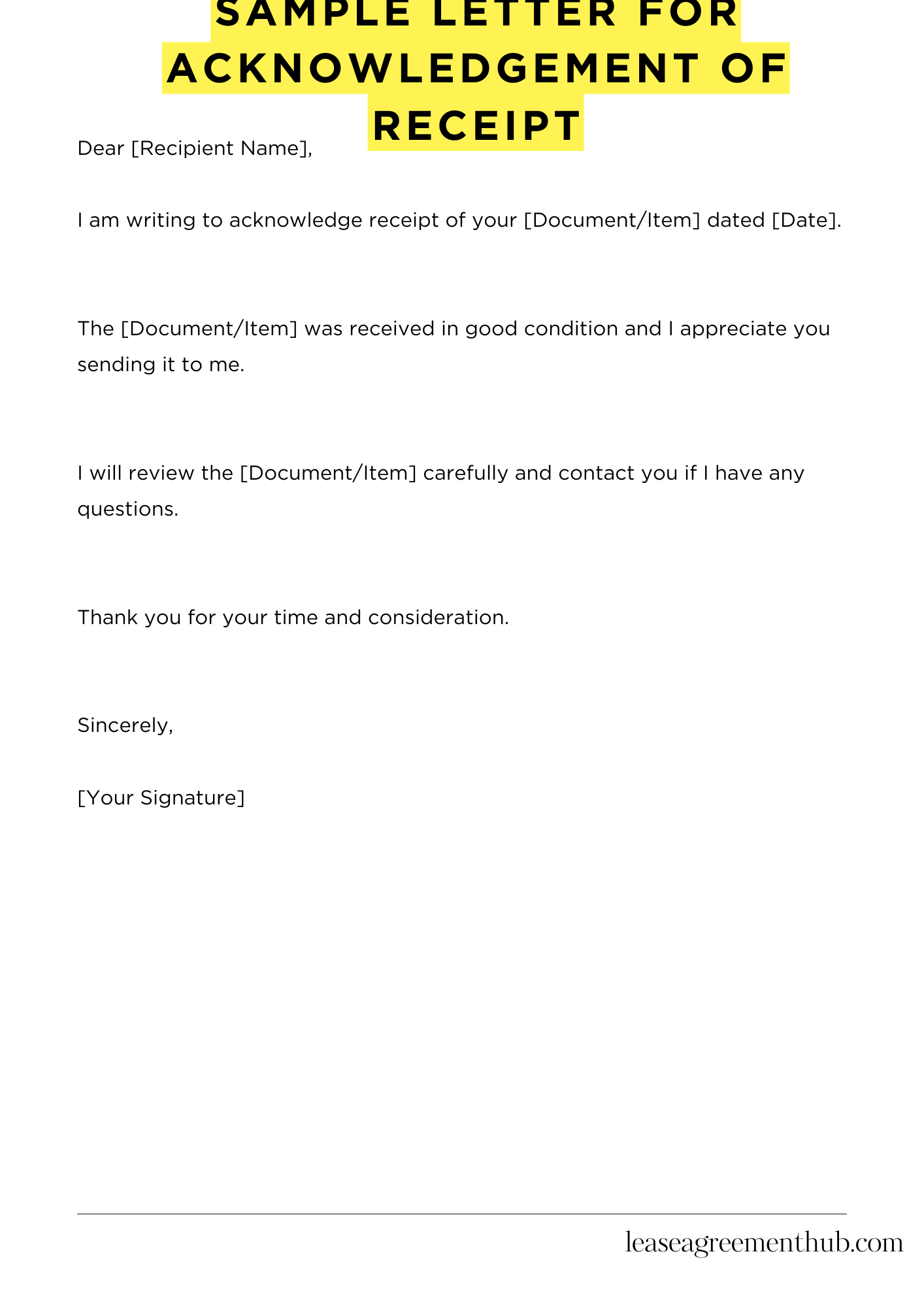A Sample Letter for Acknowledgement of Receipt is a written document that confirms the receipt of a specific item or document. Its main purpose is to provide proof that something has been received, whether it’s a package, a payment, or an important document. This letter helps maintain clear communication between parties and can serve as a legal record if needed.
In this article, we will share various templates and examples of Acknowledgement of Receipt letters. These samples are designed to help you create your own letter quickly and easily. Whether you need to acknowledge a job application, a payment, or any other item, we’ve got you covered with user-friendly options.
By using our provided samples, you can save time and ensure that your letters are clear and professional. Writing an acknowledgment letter doesn’t have to be complicated. With our templates, you can focus on what matters most while ensuring you communicate effectively.
Sample Letter For Acknowledgement Of Receipt
[Your Name]
[Your Address]
[City, Postal Code]
[Email Address]
[Phone Number]
[Date]
[Recipient Name]
[Recipient Position]
[Company/Organization Name]
[Address]
[City, Postal Code]
Dear [Recipient Name],
I am writing to acknowledge receipt of your [Document/Item] dated [Date].
The [Document/Item] was received in good condition and I appreciate you sending it to me.
I will review the [Document/Item] carefully and contact you if I have any questions.
Thank you for your time and consideration.
Sincerely,
[Your Signature]

How to Write a Sample Letter for Acknowledgement of Receipt
Have you ever received something in the mail and wondered how to acknowledge it? Maybe it was a package, a document, or even a letter. Sometimes, a simple “thank you” isn’t enough. This is where an acknowledgment letter comes in handy. It’s a formal way to confirm that you’ve received something and to provide any necessary information.
Why Write an Acknowledgement Letter?
There are many reasons why you might need to write an acknowledgement letter. It can be used to:
- Confirm receipt of a package, document, or other item
- Provide details about the item received
- Acknowledge a request or inquiry
- Show appreciation for something received
- Establish a paper trail for legal or business purposes
Key Elements of an Acknowledgement Letter
A well-written acknowledgement letter should include the following elements:
- Your Name and Address: Start with your name and address at the top of the letter. This helps the recipient know who sent the letter.
- Date: Include the date the letter was written. This helps keep track of when the acknowledgement was sent.
- Recipient’s Name and Address: Clearly state the recipient’s name and address. This ensures the letter goes to the right person.
- Subject Line: Use a clear and concise subject line that summarizes the purpose of the letter. For example, “Acknowledgement of Receipt – [Item Description]”.
- Greeting: Start with a formal greeting, such as “Dear [Recipient’s Name]”.
- Acknowledgement of Receipt: State clearly that you have received the item. Be specific about what you received. For example, “This letter is to acknowledge receipt of your package containing [item description]”.
- Additional Information: If necessary, include any additional details about the item received. This might include the date it was received, the condition of the item, or any other relevant information.
- Closing: End with a polite closing, such as “Sincerely” or “Regards”.
- Your Signature: Sign your name below the closing.
Sample Acknowledgement Letter
Here is a sample acknowledgement letter you can use as a guide:
[Your Name]
[Your Address]
[Date]
[Recipient’s Name]
[Recipient’s Address]
Subject: Acknowledgement of Receipt – Package
Dear [Recipient’s Name],
This letter is to acknowledge receipt of your package containing [item description] on [date]. The package arrived in good condition.
Thank you for your prompt delivery.
Sincerely,
[Your Signature]
[Your Typed Name]
Tips for Writing an Effective Acknowledgement Letter
Here are some tips to help you write a professional and effective acknowledgement letter:
- Be clear and concise: Use simple language and avoid jargon.
- Be polite and professional: Use a formal tone and avoid slang or informal language.
- Proofread carefully: Make sure your letter is free of errors in grammar and spelling.
- Keep a copy for your records: Always keep a copy of the letter for your own records.
By following these tips, you can write an effective acknowledgement letter that will help you stay organized and on top of your correspondence.
FAQs
How can I customize an acknowledgement letter for different types of receipts?
To customize an acknowledgement letter, specify the type of receipt, such as payment or donation. Include essential details like the amount, date, and purpose. Adjust the tone based on the recipient and context, ensuring clarity and professionalism throughout the letter.
What are the key elements to include in an acknowledgement letter for a payment?
Key elements of a payment acknowledgement letter include the payment amount, date received, invoice number, and payment method. Express gratitude and confirm the transaction was successful. Additionally, mention any relevant details about future interactions or services provided.
Can you provide a template for acknowledging receipt of a donation?
Dear [Donor’s Name],
Thank you for your generous donation of [amount] received on [date]. Your support is invaluable to our mission. We appreciate your commitment and look forward to sharing our progress with you. Sincerely, [Your Name], [Your Position].
How should I address an acknowledgement letter to a business partner?
Address an acknowledgement letter to a business partner formally. Use their title and last name, such as “Dear Mr./Ms. [Last Name].” Maintain a professional tone throughout the letter, expressing appreciation for their collaboration and outlining any next steps.
What tone should I use in an acknowledgement letter for a personal receipt?
The tone of an acknowledgement letter for a personal receipt should be warm and friendly yet respectful. Express genuine gratitude and personalize the message to reflect your relationship with the recipient. Keep it concise while conveying appreciation effectively.
Related: